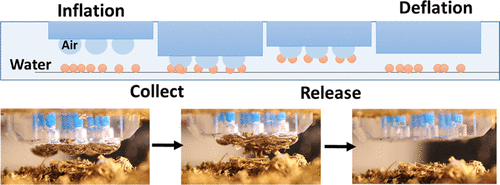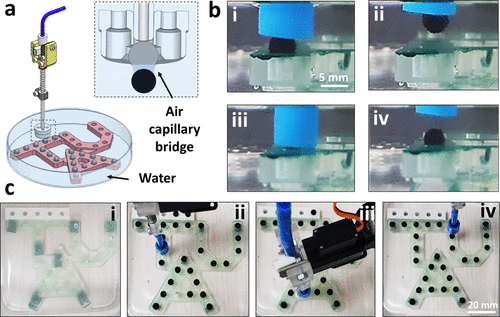The researchers explain that underwater, many insects use tiny bristles that allow them to trap and stabilize water-repellent air bubbles that cover their bodies. As these weeks come into contact with surfaces, they form bridges made of air that allow insects to go underwater. Now this has also been applied to the robot

A technology developed at Tel Aviv University will allow for the first time in the world robots to pick up tiny objects less than a millimeter in size. As part of the research, the researchers built a robotic arm with a special XNUMXD-printed head that can stabilize air bubbles in order to create "capillary bridges" (having the property of capillaries) made of air only. The capillary property means that liquids are able to "climb" up thin tubes in the absence of external forces such as gravity, and sometimes even against them. According to the researchers, the robotic arm can be used in the automation of experiments with biological cells in an aqueous environment, in micro devices in a liquid environment, in the manipulation and arrangement of small objects under water and even in the cleaning of surfaces immersed in liquid.
The research was carried out under the leadership of Dr. Beth-El Panhsik, a senior faculty member at the School of Mechanical Engineering in the Ivy and Alder Fleishman Faculty of Engineering, together with her students in the Laboratory for Biomimetics of Mechanical Systems and Surfaces. The study was published on the cover of the prestigious journal ACS Applied Materials & Interfaces.

The researchers explain that underwater, many insects use tiny bristles that allow them to trap and stabilize water-repellent air bubbles that cover their bodies. As these weeks come into contact with surfaces, they form bridges made of air that allow insects to go underwater.
In this way, similar to insects, the researchers were able to show that capillary bridges of air can be used to lift and place many small and light objects (on the order of a millimeter and even less) under water, which cannot be lifted and released in any other way. These objects include thin sheets, perforated or rough surfaces, tiny particles of various shapes, dirt and more.
Dr. Panhsik explains: "As robotic systems become smaller, they are more affected by surface forces. For example, the forces that cause small insects to become trapped on the surface of water without being able to break free. In this case, we turned the disadvantage into an advantage - we harnessed these surface forces in order to perform tasks that involve moving small and light objects, on the order of a millimeter or less."
Dr. Panhsik elaborates: "We were able to imitate the principle of action of insects and translate it into a controlled mechanical process that can be applied technologically. In addition, we showed that it is possible to fold thin sheets under water, similar to origami, by using air bubbles. As far as is known, there is no gluing or holding mechanism capable of performing all these operations on such a large variety of tiny particles and objects, and this without the use of glue and in a precise, simple and reversible way, since the trapped air can be pumped out at the appropriate time and place and thus free the particles from gluing ".
In contrast to attachment and adhesion mechanisms based on chemical glue, in this study no chemicals are used, therefore in cases where infections are a significant risk, such as in medical procedures or biological experiments, foreign substances cannot be introduced into the work environment. The robotic arm opens up the possibility of cleaning the liquid working environment from contaminant particles, something that cannot be done by conventional robotic arms.
Dr. Panhsik concludes: "In our research, we are interested in systems in nature, especially in insects, to get inspiration for the development of small robotic systems, or those that make use of physical principles used by insects in nature in order to survive and perform important operations in air or water. For this purpose, the group includes students from mechanical engineering, biomedical engineering, materials engineering and physics. This is what gives us a great advantage in research that is multidisciplinary and in finding unconventional ideas and creative solutions in the field of robotics and materials, and indeed in this case we were able to think outside the box and arrive at a quality demonstration and performance rule."
More of the topic in Hayadan:
- Who needs a molecular car?/Galileo
- Former chairman of Mekorot Buki Oren: The world will have to find cheap sources to add another 50% to global water consumption within 20 years
- An electric battery that runs on water
- Why do many insects on the islands have no wings?
- The UN also states - we must find a solution to the world's water problem

One response
Air bubbles repel water, not /water repellent/
The researchers explain, not /explain/, and alternatively the researchers explain
What happened?